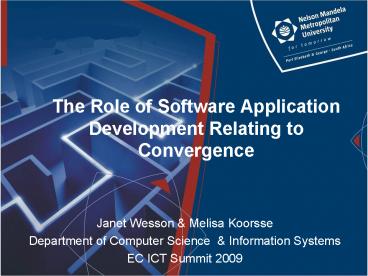The Role of Software Application Development Relating to Convergence - PowerPoint PPT Presentation
1 / 24
Title:
The Role of Software Application Development Relating to Convergence
Description:
Hotel Search Service. Provides hotel reservation functionality. Travel ... Provides hotel, airline ticket & car reservations. USER. Invokes (using ... – PowerPoint PPT presentation
Number of Views:107
Avg rating:3.0/5.0
Title: The Role of Software Application Development Relating to Convergence
1
The Role of Software Application Development
Relating to Convergence
- Janet Wesson Melisa Koorsse
- Department of Computer Science Information
Systems - EC ICT Summit 2009
2
Agenda
- What is convergence?
- What challenges does convergence present?
- How can software development meet these
challenges? - What research is being done to meet these
challenges?
3
Digital Convergence
- Driven by TIME industries
- Combines audio, video, data and voice
communication services
4
Digital Convergence
- Ability to access same services and content using
different terminals over different types of
networks. - New, innovative solutions.
- Convergence of applications, devices and networks
is impacting traditional industries. - Organisations need to be agile to adapt rapidly.
5
Converged Networks
- Network convergence.
- Telecom and IT industry convergence.
- Need for common telecom and IT service
capabilities. - Service providers need to include current telecom
network services into their service offerings. - End users expect seamless integration of public
and enterprise web and voice services.
6
Converged Applications
- For example
- Can download music on PC and mobile device.
- Media no longer broadcast to user but defined by
viewer or user - Interactive media.
- Fast broadband and new web services break
constraints of traditional capacity and broadcast
methods.
7
Converged Devices
- Devices
- Smartphones, Internet-enabled entertainment
devices. - Improve quality of essential services.
- For example
- Use of RFID tags to improve healthcare delivery
- Wireless network sensors in cities
- Not just about cool gadgets but whole new way of
life.
8
Ubiquitous Computing
- Increasing number of computing devices to
interact with - End-users need to interact with technology in the
most natural and convenient way possible. - Computing environments able to sense and respond
to user requirements. - Major interoperability and integration
challenges. - Convergence of pervasive computers and
communication networks.
9
What is needed?
- Need to ensure that software applications will
support and facilitate digital convergence. - Anytime, any place, any platform content and
services are needed.
10
Solution?
- A service-oriented architecture (SOA) approach to
software application development, and - Adaptive user interfaces and service elements.
11
Service-Oriented Architecture
- Distributed application architecture style.
- Business applications and data decomposed into
discrete components, called services. - Service interface independent of implementation
(loosely-coupled). - Ensures business communication is no longer
dependent on compatibility of IT infrastructure. - Supports flexibility and reusability.
- Internet-based services called web services.
12
Web Services Example
Hotel Search Service Provides hotel reservation
functionality
Invokes (using SOAP messages according to WSDL
definition)
Invokes (using GUI)
Travel Agent Service Provides hotel, airline
ticket car reservations
USER
13
Web Services
- Web Services support interaction using different
devices. - User interfaces (UIs) of web services should
adapt to different device characteristics. - Burden to develop multiple UIs.
- Desirable to automatically generate UIs for
services.
14
Mobile 2.0
- User-oriented perspective on services for mobile
devices. - New mobile services in
- Social emotional communication,
- Pervasive games, and
- Mobile media.
- Absolute location, proximity of other users or
services. - Need to make development of mobile applications
easier.
15
Adaptive User Interfaces
- Provide seamless, natural end-user interaction.
- Location-based services.
- Adapt to different devices.
- Create and maintain user profiles.
- Service provision
- User requested
- Proactive activation
16
Research _at_ NMMU
- Distributed Multimedia Unit of Telkom/NMMU CoE
based in Department of Computer Science
Information Systems. - Industry partners
- Telkom, Dimension Data and THRIP
- Current research project (2008-2010)
- An Investigation into Intelligent Tools and
Techniques to Support Service Utilisation for
SOAs
17
Research _at_ NMMU
- Research hypothesis
- IUIs can optimise benefits of SOA.
- Provide streamlined, customised interfaces.
- Primary research goal
- Develop intelligent tools and techniques to
support utilisation of services offered by
company with SOA. - Several postgraduate research projects focusing
on different aspects.
18
Postgraduate project (1)
- Adaptive User Interface Using a SOA - Emile
Senga - Objective
- Develop and evaluate a model that leverages SOA
to deliver application UI to users.
19
Postgraduate project (2)
- Adaptive Interfaces for Mobile Preference-Based
Searching - Ryan Hill - Objective
- Determine the extent to which an AUI can improve
the effectiveness and satisfaction of mobile
tourist guides.
20
Postgraduate project (3)
- Customer Profiling Using a SOA - Felix Ntawanga
- Objective
- Investigate how customer profiles can be used to
provide personalisation in SOA environment.
21
Postgraduate project (4)
- A Comparison of Legacy System Modernisation
Approaches in a SOA - Meredith Barnes - Objective
- Develop white- and black-box modernisation
approaches that generate data services for legacy
systems to be used in a SOA. - Evaluation of suitability of the two approaches.
22
Postgraduate project (5)
- A Scalable Remote Information Centre using a SOA
Framework - Mohamed Cassim - Objective
- Provide a Remote Information Centre using a SOA
framework and cloud computing infrastructure. - Accessible from desktop and mobile web-browsers.
23
Postgraduate project (6)
- An AUI incorporating a SOA for a Remote
Information Centre - Devereaux Joubert - Objective
- Facilitate delivery of a RIC across various
environments focusing on mobile devices.
24
So What?
- Digital convergence presents several challenges.
- Era of ubiquitous computing is here.
- Software application development needs to become
agile and adaptive. - Solution lies in SOA and AUIs.
- Research _at_ NMMU is exploring possible solutions.
- Question
- Is the IT industry ready to meet these
challenges? -
- - END -































